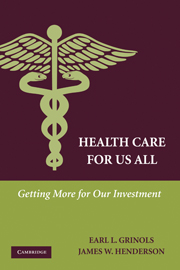Book contents
- Frontmatter
- Contents
- List of Tables
- List of Figures
- Preface
- Acknowledgments
- Executive Summary of the Targeted Intervention Plan
- PART I GOALS AND WORKING PRINCIPLES
- PART II BACKGROUND ECONOMICS AND ETHICS
- PART III APPLICATION
- PART IV PROTECTIVE MEASURES
- 9 Forestalling Free Riders
- 10 Preserving Prices
- 11 Inducing Innovation
- 12 Summary
- A Top Ten Goals for the American Health Care System
- B Badly Done Insurance Programs Can be Worse Than No Insurance
- C Incentive Symmetry and Intervention Principle
- D Plan Workability
- E Market Power Response to Insurance
- Glossary and Definitions
- References
- Index
10 - Preserving Prices
Published online by Cambridge University Press: 05 June 2012
- Frontmatter
- Contents
- List of Tables
- List of Figures
- Preface
- Acknowledgments
- Executive Summary of the Targeted Intervention Plan
- PART I GOALS AND WORKING PRINCIPLES
- PART II BACKGROUND ECONOMICS AND ETHICS
- PART III APPLICATION
- PART IV PROTECTIVE MEASURES
- 9 Forestalling Free Riders
- 10 Preserving Prices
- 11 Inducing Innovation
- 12 Summary
- A Top Ten Goals for the American Health Care System
- B Badly Done Insurance Programs Can be Worse Than No Insurance
- C Incentive Symmetry and Intervention Principle
- D Plan Workability
- E Market Power Response to Insurance
- Glossary and Definitions
- References
- Index
Summary
All that a man has will he give for his life.
Satan, quoted in Job 2:4Competition and market forces have been absent from our health care system, and that has hurt working families tremendously. We are excited to take the lead in doing what we do best – driving costs out of the system – and passing those savings to our customers.
H. Lee Scott, Chief Executive Officer, Wal-Mart, 2006Summary: Two things are certain: People can be made to pay more for health care than it costs to provide, and prices can be restrained and made useful only by re-establishment of competitive forces, or their approximation, that rationalize the current (dysfunctional) health care market.
Background
The patient entered the doctor's office with a fishbone dangerously caught in his throat. Desperate, he waited anxiously until the doctor skillfully removed it. “How much do I owe you, Doc?”
“About half as much as you were willing to pay when you came in.”
The story makes a good point: if health care were priced according to willingness to pay alone, doctors and hospitals could extract far more than the cost of providing services. The same can be said for many equally vital commodities. We do not price water at willingness to pay, for example, and neither should we do so for health care. Water can be purchased quite reasonably in grocery stores everywhere at prices roughly comparable to its cost of provision because competition among suppliers acts as a self-correcting force.
- Type
- Chapter
- Information
- Health Care for Us AllGetting More for Our Investment, pp. 178 - 192Publisher: Cambridge University PressPrint publication year: 2009

